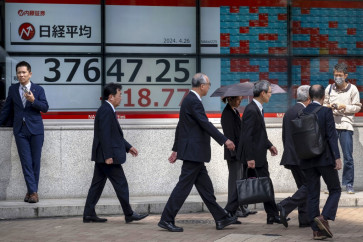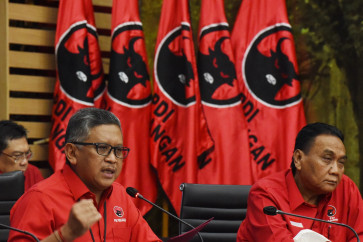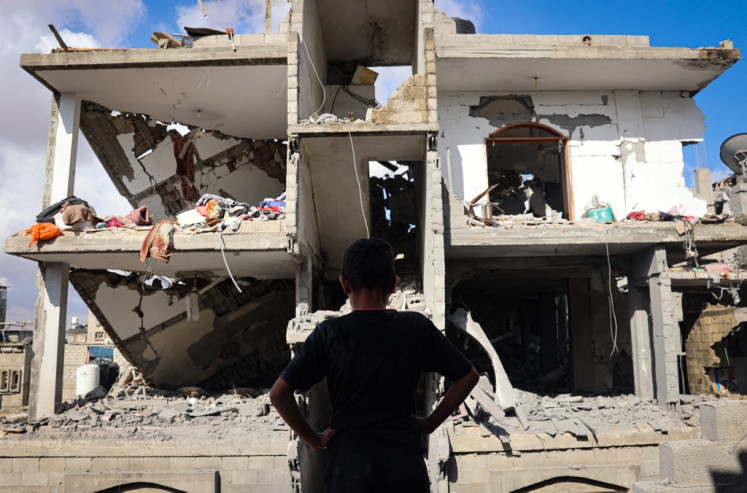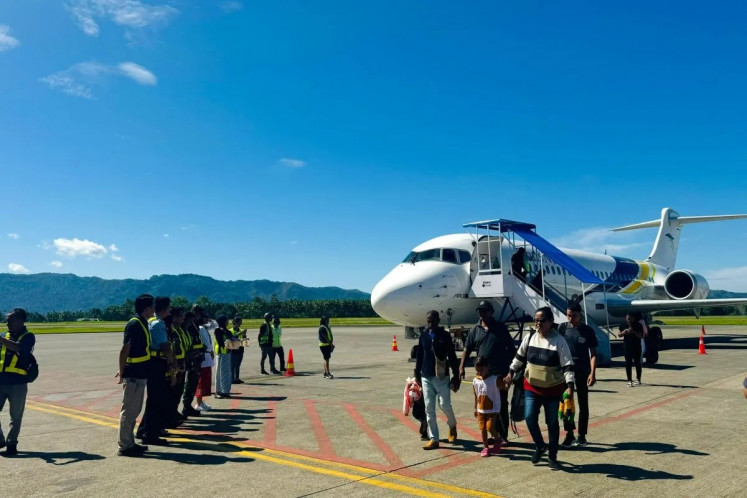Child of Krakatau under close watch
Paradise lost: Staff members of the Aviredita Villa complex on Anyer Beach in Serang, Banten, prepare to move vehicles damaged by the Sunda Strait tsunami
Change Size

P
aradise lost: Staff members of the Aviredita Villa complex on Anyer Beach in Serang, Banten, prepare to move vehicles damaged by the Sunda Strait tsunami. The National Disaster Mitigation Agency reported that as of Tuesday, 429 people had been killed, 1,485 had been injured and 154 others remained missing. Meanwhile, 16,082 people are reported to have sought refuge at temporary shelters. The tsunami was caused by the eruption of Anak Krakatau, it said.(JP/Dhoni Setiawan)
People living along the coasts of the Sunda Strait have been advised to stay clear of beaches as the authorities look further into the cause of a powerful tsunami that killed over 400 people and injured around 1,500 in Banten and Lampung on Saturday.
The Sunda Strait tsunami — the latest in a string of natural disasters to hit the country this year — is believed to have been generated by the collapse of the flank of Anak Krakatau, which has been erupting since June.
There was, however, no way to predict whether another tsunami or undersea landslide could happen, because further study at the volcano was necessary, said Kristianto, the head of western region volcano mitigation at the Center for Volcanology and Geological Hazard Mitigation (PVMBG).
“We cannot predict anything right now because we have to conduct a study to calculate the stability of the volcano’s slopes in order to see the probability of another collapse,” Kristianto told The Jakarta Post on Tuesday.
Anak Krakatau has since continued to be active, spewing a 300 to 600-meter column of thick black smoke into the sky over the last two days, according to a statement released by the Meteorology, Climatology and Geophysics Agency (BMKG) and the officials at the volcano observation post.
Hot ash clouds were seen heading to the south, while a rumbling sound was heard from the observation post, the statement said, while Anak Krakatau also produced a continuing tremor with an amplitude of 9 to 35 millimeters.
However, Kristianto said such volcanic activity was considered normal and the PVMBG still needed to look into whether the landslide that triggered the tsunami was caused by the accumulation of the erupted materials or not. “The collapse occurred on the steep slope at the west part and we must look into this because we are also in the middle of the rainy season and anywhere steep can experience a landslide,” he said.
Anak Krakatau, which means Child of Krakatau, is located in the middle of the Sunda Strait connecting Sumatra and Java, and emerged in 1927 from the remnants of Mount Krakatau, which erupted in 1883, triggering a tsunami that killed around 36,000 people.
Indonesia has 127 active volcanoes and is located on the Pacific Ocean’s Ring of Fire, where earthquakes and volcanic eruptions are frequent.
National Disaster Mitigation Agency (BNPB) spokesperson Sutopo Purwo Nugroho said Anak Krakatau, whose height reached 338 m today, was growing by 4 to 6 m per year. “We will not see [Anak Krakatau] erupt to the extent of the 1883 eruption,” Sutopo said. “Many experts say that it may need 500 more years to produce such a catastrophic eruption.”
While announcing that the tsunami originated from a partial collapse of the volcano, which caused a landslide large enough to generate massive waves, the BMKG called for residents on Monday to stay clear of the beaches in the Sunda Strait.
Rudy Suhendar, head of the Geology Division at the Energy and Mineral Resources Ministry, concurred with Kristianto, saying that authorities still needed to conduct a study at Anak Krakatau before drawing any conclusions.
So far, authorities have only observed the volcano’s activity and the location of the undersea landslide from satellite imagery and seismic data, because the weather conditions were still too extreme for them to depart to Anak Krakatau, he said, adding that they would depart as soon as the weather was favorable for them.
“We need to conduct a study at the site to calculate Anak Krakatau’s vulnerability and what is important for now is that the public remain vigilant […] while all relevant officials will continue to monitor the volcano and the waves,” Rudy said.
Some residents who were affected by the disaster, meanwhile, said they were not worried about the activity of the volcano.
“Nothing ever happened with the sea. The waves were fine, the volcano looked fine too from afar. Saturday’s incident occurred without sign,” said Arisah, 60, a resident of Carita, one of the areas affected by the tsunami.
Arisah, her husband and her children left their house to stay at an evacuation camp on a hill in Pandeglang, however, she said she would not stay too long in the camp and would return to their house soon.
“We’re of course afraid another tsunami will happen. But we just keep believing that whatever happens is part of God’s plan,” she added.
- Arya Dipa contributed to this story from Bandung.









